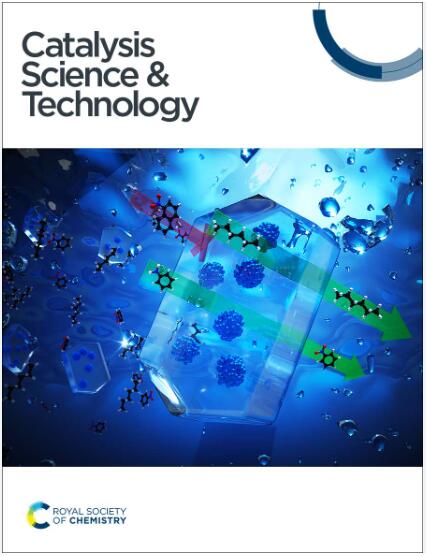近红外光触发的NaYF4: Yb3+, Tm3+@ZnO@RGO@ ag光催化剂高效降解四环素†
IF 4.4
3区 化学
Q2 CHEMISTRY, PHYSICAL
引用次数: 0
摘要
在光催化领域,利用太阳能,特别是近红外(NIR)光谱,提出了艰巨的挑战。为了克服这些问题,一种新型的nir响应光催化剂(表示为NYT@ZnO@RGO@Ag)被精心制作。该光催化剂由还原氧化石墨烯(RGO)支撑的NaYF4: Yb3+, Tm3+@ZnO结构组成,并进一步与纳米银复合。作为模型化合物,对其光降解四环素类抗生素的性能进行了严格评价。利用上转换材料、宽禁带半导体和局部表面等离子体共振(LSPR)的独特特性,NYT@ZnO@RGO@Ag催化剂在近红外光照射下对TC的光降解率达到了令人印象深刻的93.6%。这一效率超过了NYT@ZnO(38.2%)和NYT@ZnO@RGO(72.3%)。在NYT@ZnO@RGO@Ag中观察到的nir驱动光催化的显著增强主要归因于从NYT到其各组分的荧光共振能量转移(FRET)的有效过程。该过程增强了光诱导载流子的产生,促进了近红外辐射下的有效转移和能量利用。本研究为nir驱动的光催化降解污染物在有限光照环境下甚至在黑暗条件下提供了一种有前途的方法。本文章由计算机程序翻译,如有差异,请以英文原文为准。
Near-infrared light-triggered NaYF4: Yb3+, Tm3+@ZnO@RGO@Ag photocatalyst for efficient degradation of tetracycline†
In the domain of photocatalysis, harnessing solar energy, particularly the near-infrared (NIR) spectrum, presents formidable challenges. To overcome these, a novel NIR-responsive photocatalyst, denoted as NYT@ZnO@RGO@Ag, was meticulously crafted. This photocatalyst comprises a NaYF4: Yb3+, Tm3+@ZnO structure supported on reduced graphene oxide (RGO) and further composited with silver nanoparticles. It was rigorously evaluated for its performance in photodegrading tetracycline (TC) antibiotics as a model compound. Leveraging the unique properties of upconversion materials, wide bandgap semiconductors, and localized surface plasmon resonance (LSPR), the NYT@ZnO@RGO@Ag catalyst exhibited an impressive photodegradation rate of 93.6% for TC under NIR light exposure. This efficiency surpassed that of NYT@ZnO (38.2%) and NYT@ZnO@RGO (72.3%). The remarkable enhancement in NIR-driven photocatalysis observed in NYT@ZnO@RGO@Ag is primarily attributed to the efficient process of fluorescence resonance energy transfer (FRET) from NYT to its each component. This process enhances photo-induced carrier generation and facilitates efficient transfer and energy utilization under NIR irradiation. The present study offers a promising approach for NIR-driven photocatalytic degradation of pollutants in environments with limited light exposure or even under dark conditions.
求助全文
通过发布文献求助,成功后即可免费获取论文全文。
去求助
来源期刊

Catalysis Science & Technology
CHEMISTRY, PHYSICAL-
CiteScore
8.70
自引率
6.00%
发文量
587
审稿时长
1.5 months
期刊介绍:
A multidisciplinary journal focusing on cutting edge research across all fundamental science and technological aspects of catalysis.
Editor-in-chief: Bert Weckhuysen
Impact factor: 5.0
Time to first decision (peer reviewed only): 31 days
 求助内容:
求助内容: 应助结果提醒方式:
应助结果提醒方式:


